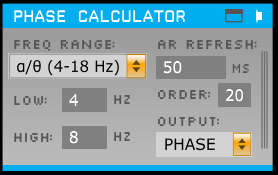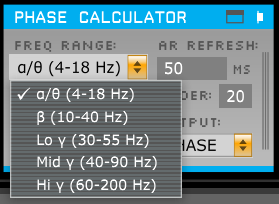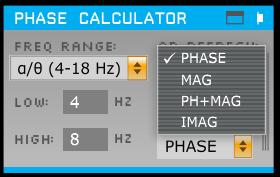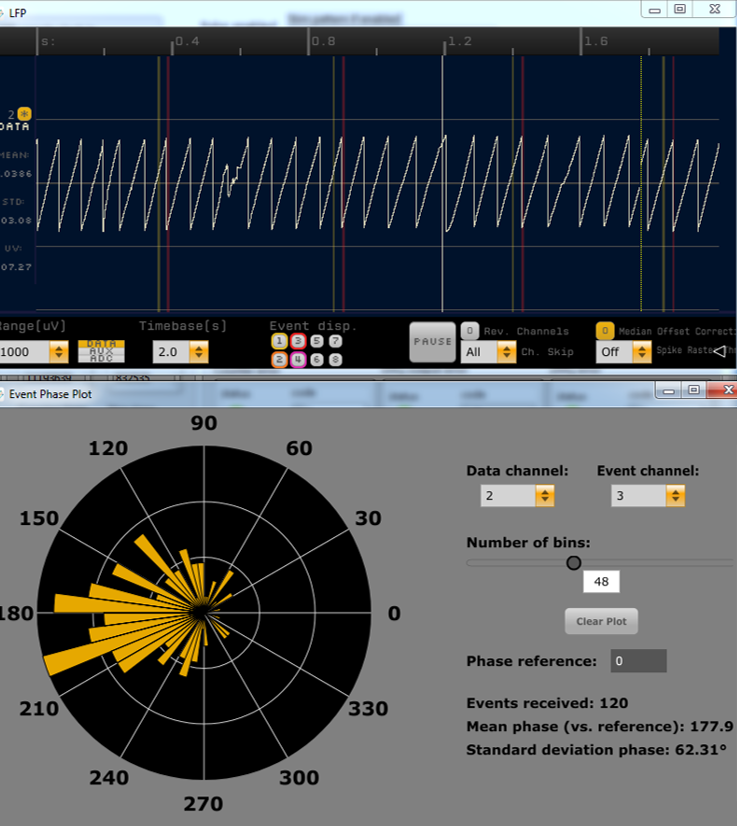A plugin for the Open Ephys GUI to estimate the phase of inputs within a specified passband in real time. Its primary purpose is to enable closed-loop stimulation, typically in combination with the Crossing Detector and either the Pulse Pal or an external stimulation system that receives ZeroMQ events (for example, the LabVIEW implementation here). It can also output the magnitude or imaginary component of the band-limited analytic signal instead of the phase. (The "PH+MAG" mode outputs both phase and magnitude, in separate channels.) Finally, the visualization tab or window can receive TTL events and display the delayed but precise phase of a specified input at the event onset samples in a rose plot. This allows real-time monitoring of stimulation accuracy.
The following article describes the algorithm used by the previous version of this plugin and the closed-loop stimulation pipeline as a whole:
Blackwood, E., Lo, M., Widge, A. S. (2018). Continuous phase estimation for phase-locked neural stimulation using an autoregressive model for signal prediction. 40th International Conference of the IEEE Engineering in Medicine and Biology Society (EMBC), Honolulu, HI, 4736-4739.
If you are just using the plugin in your project, you can cite this version of the code using the DOI listed in the header of this file.
-
You are on the
cmake-guibranch, which uses a Hilbert transformer FIR filter - actually one of several, depending on the frequency band you are filtering to. This is more efficient than the original (published) algorithm since it doesn't require as much AR model-based prediction nor calculating an FFT on each step. -
If you want, you can switch to the
old-versionbranch, which uses the Fourier-transform-based Hilbert transform over a sliding window to estimate the analytic signal (from which we derive the phase). We have been testing variants of this algorithm in our lab since mid-2016, and it is now fairly polished, but is somewhat less computationally efficient than the newer version.
This plugin must now be built outside of the main GUI file tree using CMake. In order to do so, it must be in a sibling directory to plugin-GUI* and the main GUI must have already been compiled.
You should use this branch if you are already using CMake to build the main GUI (in development as of writing). Otherwise, use the master branch.
You must also first install the "OpenEphysFFTW" common library, available here.
See PhaseCalculator/CMAKE_README.txt and/or the wiki page here for build instructions.
* If you have the GUI built somewhere else, you can specify its location by setting the environment variable GUI_BASE_DIR or defining it when calling cmake with the option -DGUI_BASE_DIR=<location>.
-
Important! Since the phase estimation algorithm is somewhat processor-intensive, by default all input channels are disabled. To enable the channels you would like to estimate the phase (or other component) of, select them in the "PARAM" section of the drawer. If "PH+MAG" is selcected as the output, this will also create the additional magnitude outputs for each selected input.
-
In the "freq range" dropdown menu, choose a range of frequencies that includes the band you want to filter to. This determines which of the pre-designed Hilbert transformer filters is used internally (since if we tried to use one filter for all frequencies, it would end up with terrible performance everywhere). Note that the delta band is just too low to get a reasonably accurate phase estimate, even when downsampling to 500 Hz as this plugin does (before interpolating the output).
-
Use "Low cut" and "High cut" to select the desired frequency passband. (Inputs should be unfiltered; the Phase Calculator uses its own bandpass filter internally.) Changing the frequency range will automatically set a default high and low cut, but they can be changed to filter to any band within the range.
-
"AR Refresh" and "Order" control the autoregressive model used to predict the "future" portion of the Hilbert buffer. AR parameters are estimated using Burg's method. The default settings seem to work well, but other settings (particularly lower orders) may also work well.
-
"Output" allows selection of which component(s) of the analytic signal to output (for all enabled channels). If PH+MAG is selected, a magnitude (amplitude envelope) output channel is added to the outputs for each selected input channel; they appear in the ascending numerical order of their corresponding input/phase output channels. See
PC_ph+mag_demo.pngfor an example of outputtng both phase and magnitude.
Clicking the tab or window button opens the "event phase plot" view. This allows non-real-time plotting of the precise phase of received TTL events on a channel of interest. The data channel must be one that is selected for processing in the Phase Calculator "params" drawer, as the filtering step is shared between real-time phase estimation and event phase visualization. All plot controls can be used while acquisition is running. "Phase reference" subtracts the input (in degrees) from all phases (in both the rose plot and the statistics).
I hope you find this to be useful! -Ethan Blackwood (ethanbb)



